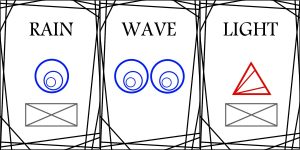Generative Study of of a deckbuilding card game
As a followup from the previous study,
Simplified Rules:
Gameplay goes in rounds, and they repeat until either the player or the monster is defeated.
In the course of a round, it is further split into 3 stages: Setup Phase, Main Phase, and Cleanup Phase
There are several zones, Your Hand, Your Deck, Your Field, Your Discard, and The Trash, and the respective Shop and Monster Decks. Cards in decks are placed face-down, while the rest have their cards face-up.
In the Setup Phase
- Look at the shop. If the cards on your board fulfill requirement of a card in the shop, you may add said card into your discard pile. Else, remove the leftmost card in the shop and reveal a new one at the right.

In the Main Phase
- You may play any number of cards in your hand onto the board
- You can resolve any of these effects

In the Cleanup Phase
- You may deal 1 damage to the monster for every trio of same colours you complete, then for every trio of different colours completed

Here there is a trio of blue, so the total damage would be 1.
- If the monster has not been defeated, look at the cards on your board. If they do not fulfill the block requirement of the monster, put the top card of your deck into the trash pile.
- Then, put all your cards on your field into the discard pile.
- If the monster has been defeated however, put the monster card into your discard pile, and then trash the following monster. (This creates more variety of monsters appearing, instead of always the same ones)

Example Monster Cards
Repeat the rounds until either player or monster have been defeated. Whenever you need to draw a card while the deck is empty, shuffle the discard pile into the deck.
Gameplay has generative elements due to the player interaction being relevant to affect or control the unreliably generated options as the deck gets shuffled giving new scenarios each time the game is played.
Giving control to the player allows the human interaction element to directly affect the outcome of a game, although they would not have perfect control over what might happen.
Elements such as trashing every other monster, as well as a shop that replaces itself, increase the amount of variation that can happen in a game, creating replayability as well as unpredictability over the flow of games.
